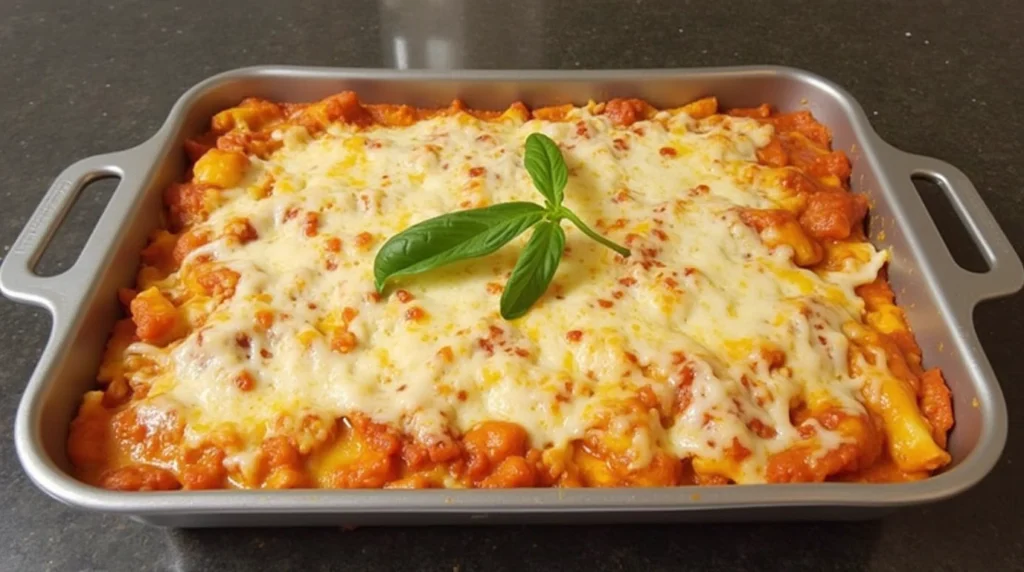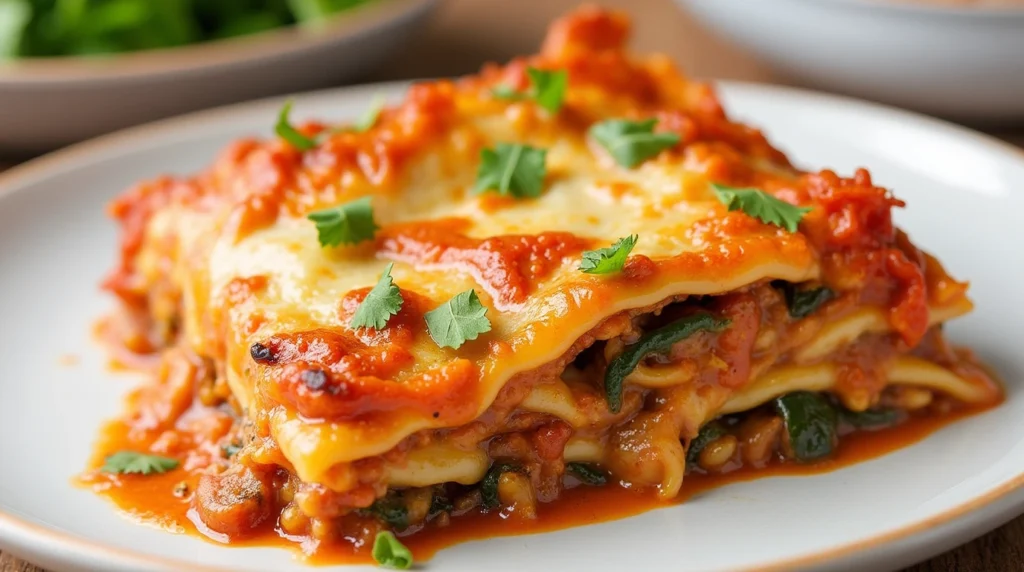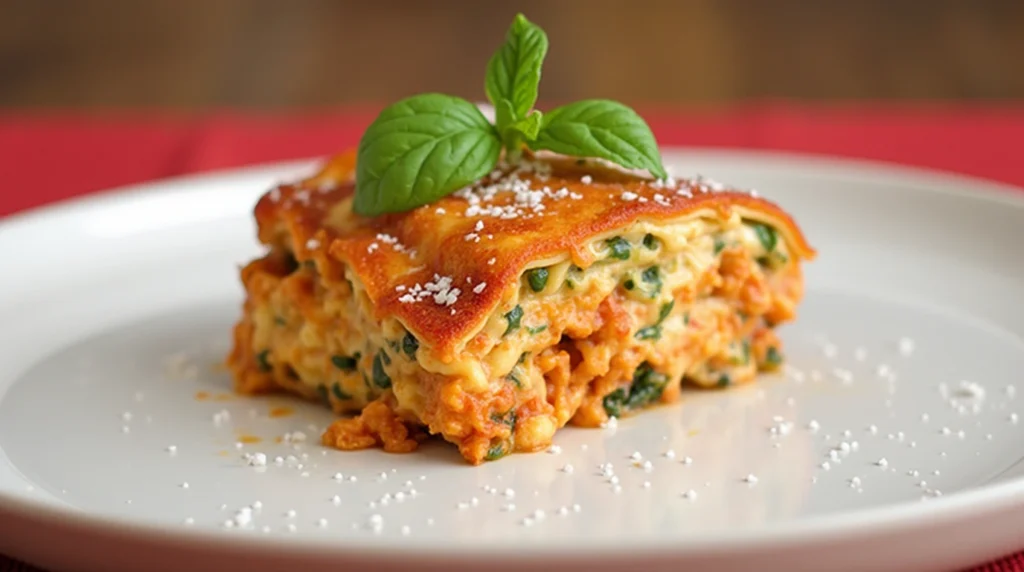Introduction

Welcome to the world of comforting, delicious, and healthy meals! Whether you’re looking for a hearty dish to satisfy your cravings or aiming to add more plant-based meals to your diet, Vegetarian Lasagna Delight is the perfect choice. Packed with vibrant vegetables, creamy cheeses, and layers of flavorful tomato sauce, this lasagna is a celebration of taste and health. Plus, it’s incredibly easy to customize to your preferences. Get ready to learn how to make this crowd-pleaser step-by-step, with tips to make it even better.
1: Ingredients for the Perfect Vegetarian Lasagna Delight
To create the perfect vegetarian lasagna, you’ll need a combination of fresh ingredients and pantry staples. Here’s what you’ll need:
Essential Ingredients
| Ingredient | Quantity | Purpose |
|---|---|---|
| Lasagna sheets (regular/gluten-free) | 12 sheets | Base for layering |
| Ricotta cheese | 2 cups | Creamy filling |
| Mozzarella cheese | 2 cups, shredded | Melty, gooey topping |
| Parmesan cheese | 1 cup, grated | Adds a savory depth |
| Zucchini | 2, thinly sliced | Provides texture and nutrition |
| Spinach | 3 cups, fresh | Adds freshness and vitamins |
| Bell peppers (red/yellow) | 2, diced | Sweet and colorful addition |
| Mushrooms | 1 cup, sliced | Earthy, hearty flavor |
| Tomato sauce/marinara | 3 cups | Base sauce for flavor |
| Fresh basil | Handful, chopped | Aromatic garnish |
| Italian seasoning | 2 tsp | Adds a robust flavor |
| Garlic | 3 cloves, minced | Enhances overall taste |
Optional Ingredient Variations
- Swap ricotta with tofu for a vegan option.
- Add eggplant or butternut squash for a seasonal twist.
- Try low-fat cheeses for a healthier version.
2: Preparing the Vegetables and Sauce
A flavorful lasagna begins with well-prepared vegetables and sauce. Here’s how to do it:
1- Step 1 – Sauté the Vegetables
- Heat olive oil in a large skillet.
- Add garlic, zucchini, bell peppers, mushrooms, and spinach.
- Sauté until softened, but not overcooked, to maintain texture.
2- Step 2 – Make a Simple Marinara Sauce
- Combine canned tomatoes, garlic, and Italian seasoning in a saucepan.
- Let it simmer for 15-20 minutes to develop deep flavors.
- Add fresh basil for a fresh, aromatic finish.
3- Step 3 – Tips to Avoid Watery Vegetables
- Salt zucchini slices before cooking to remove excess water.
- Pat cooked vegetables dry with paper towels.
3: Layering the Vegetarian Lasagna
Layering is where the magic happens! Follow this sequence for the perfect lasagna:
1- Step 1 – Prepare the Baking Dish
- Lightly grease the dish and spread a thin layer of sauce on the bottom.
2- Step 2 – Layer the Ingredients
- Start with lasagna sheets.
- Add a layer of ricotta cheese.
- Top with sautéed vegetables.
- Spread a layer of marinara sauce.
- Sprinkle mozzarella and parmesan.
- Repeat layers until the dish is full.
3- Step 3 – Tips for Even Layering
- Distribute each ingredient evenly across the dish.
- Finish with a generous layer of mozzarella for a golden, bubbly top.

4: Baking Your Vegetarian Lasagna to Perfection
1- Step 1 – Preheat the Oven
- Set your oven to 375°F (190°C).
2- Step 2 – Bake in Two Stages
- Cover the dish with foil and bake for 30-40 minutes.
- Remove foil and bake for another 10 minutes to brown the cheese.
3- Step 3 – Let It Rest
- Allow the lasagna to cool for 10-15 minutes before slicing.
5: Tips, Variations, and Serving Suggestions
Tips for Making Ahead
- Assemble the lasagna, cover tightly, and refrigerate for up to 24 hours before baking.
Recipe Variations
- Use whole-grain lasagna sheets for added fiber.
- Make it vegan by using dairy-free cheeses.
Serving Ideas
- Pair with a crisp green salad and garlic bread.
- Serve with roasted vegetables for a complete meal.
Storing Leftovers
- Store in an airtight container in the fridge for up to 3 days.
- Freeze individual portions for easy weeknight meals.
6: Nutritional Benefits of Vegetarian Lasagna Delight
- Rich in Nutrients:
- Highlight the abundance of vitamins, minerals, and fiber from vegetables like zucchini, spinach, and bell peppers.
- Discuss protein sources such as ricotta, mozzarella, or tofu (if vegan).
- Healthier Alternative to Traditional Lasagna:
- Compare calorie and fat content of this recipe to a traditional meat lasagna.
- Explain the benefits of incorporating plant-based meals into your diet.
- Customizable for Dietary Needs:
- Suggest substitutions for low-carb, gluten-free, or vegan preferences.
- Benefits of reducing saturated fats with plant-based ingredients.
7: Troubleshooting Common Lasagna Problems
- Why Is My Lasagna Watery?
- Address common causes (e.g., excess moisture in vegetables, overly wet ricotta).
- Solutions: Properly sauté vegetables, drain ricotta, use thicker sauce.
- How to Prevent Burnt Edges:
- Recommend using foil for the initial baking phase.
- Tips on adding extra sauce around the edges.
- Getting Perfectly Cooked Lasagna Sheets:
- Explain the benefits of pre-cooking sheets versus oven-ready sheets.
- How to Avoid Overbaking or Dry Lasagna:
- Provide baking time guidelines.
- Recommend letting the lasagna rest after baking to settle layers.
8: Step-by-Step Recipe Table
| Ingredient | Quantity | Notes |
|---|---|---|
| Lasagna sheets | 9-12 sheets | Regular or gluten-free |
| Ricotta cheese | 2 cups | Use firm tofu for vegan option |
| Shredded mozzarella | 2 cups | Plant-based alternatives work too |
| Grated parmesan | ½ cup | Optional or vegan substitute |
| Zucchini | 1 medium | Thinly sliced |
| Bell peppers | 2 medium | Diced |
| Spinach | 2 cups | Fresh or frozen (thawed/drained) |
| Mushrooms | 1 cup | Sliced |
| Marinara sauce | 3-4 cups | Homemade or store-bought |
| Italian seasoning | 2 tsp | Add chili flakes for spice |
| Fresh basil | ¼ cup | Chopped |
| Garlic | 3 cloves | Minced |

9: Pro Tips for Perfect Vegetarian Lasagna
- Balance Your Layers: Ensure an even distribution of sauce, vegetables, and cheese for consistent flavors in every bite.
- Boost the Flavor: Add a splash of red wine or balsamic vinegar to the marinara sauce.
- Use Fresh Herbs: Fresh basil or parsley as garnish enhances both flavor and presentation.
- Don’t Rush the Rest Time: Letting the lasagna cool slightly prevents messy slices.
10: Serving and Presentation Ideas
- How to Serve:
- Use a sharp knife to cut neat slices. Serve on warmed plates to keep the lasagna hot longer.
- Add a sprinkle of freshly chopped parsley or basil for a professional touch.
- Plating Suggestions:
- Pair each slice with a small scoop of marinara sauce for added color and flavor.
- Place lasagna on a bed of fresh greens or arugula for a vibrant contrast.
- Accompaniments:
- Beverages: A glass of red wine or a refreshing lemon-infused sparkling water.
- Sides: A crisp Caesar salad, roasted brussels sprouts, or buttery garlic bread.
11: Storing and Reheating Vegetarian Lasagna
- How to Store Leftovers:
- Place lasagna slices in airtight containers and refrigerate for up to 3-4 days.
- For longer storage, freeze individual portions wrapped in foil and stored in a freezer-safe bag.
- Reheating Tips:
- For refrigerated lasagna: Microwave on medium heat or bake at 350°F for 15-20 minutes.
- For frozen lasagna: Thaw overnight in the fridge, then bake at 375°F for 30-40 minutes.
- Prevent Drying Out:
- Cover with foil during reheating and add a small splash of marinara sauce to keep it moist.
12: Why Vegetarian Lasagna is Perfect for Gatherings
- Crowd-Pleasing Dish:
- Lasagna is universally loved and easy to prepare in advance, making it perfect for potlucks, family dinners, or holiday gatherings.
- Accommodates Different Diets:
- Customizable to meet dietary restrictions (vegan, gluten-free, low-carb).
- Serves a Large Group:
- A single 9×13-inch lasagna can serve up to 10 people, making it budget-friendly for hosting.

13: Creative Variations for Vegetarian Lasagna
- Pesto Lasagna:
- Replace marinara sauce with basil pesto for a unique flavor twist.
- Mexican-Inspired Lasagna:
- Use salsa, black beans, corn, and cheddar cheese for a Tex-Mex spin.
- Eggplant or Zucchini Lasagna:
- Swap lasagna sheets for thinly sliced eggplant or zucchini for a low-carb alternative.
- White Sauce Lasagna:
- Use a béchamel or Alfredo sauce instead of marinara for a creamy option.
14: The History and Origin of Lasagna
- Brief Historical Context:
- Lasagna originated in Italy, with variations appearing in regions like Emilia-Romagna and Naples.
- Traditionally made with meat sauces, the vegetarian version has gained popularity as dietary preferences have evolved.
- Cultural Significance:
- Lasagna is often associated with comfort food and special occasions in many cultures worldwide.
- Modern Adaptations:
- Today, vegetarian and vegan versions are celebrated for their health benefits and inclusivity.
15: Encouraging Sustainability Through Vegetarian Cooking
- Eco-Friendly Benefits of Vegetarian Meals:
- Reducing meat consumption lowers carbon footprints and conserves natural resources.
- Vegetarian dishes like lasagna use fewer water-intensive ingredients compared to meat-based meals.
- Tips for a Sustainable Kitchen:
- Use fresh, seasonal vegetables to reduce the environmental impact of transportation.
- Compost vegetable scraps and use them for gardening to minimize waste.
- Choose organic or locally sourced ingredients when possible.
- Inspiring Change:
- Highlight how even small steps, like swapping meat-based meals for vegetarian options a few times a week, can make a big difference for the planet.
16: Nutrition Benefits of Vegetarian Lasagna Delight
- Nutrient-Rich Ingredients:
- Vegetables: Packed with vitamins, minerals, and antioxidants to support overall health.
- Cheese (or vegan alternatives): A good source of protein and calcium for strong bones and muscles.
- Lasagna Sheets (Whole-Grain Options): Provide fiber for better digestion and sustained energy.
- Healthier Substitutions:
- Use low-fat cheese or swap ricotta for blended tofu for a lighter, protein-rich layer.
- Opt for whole-grain or gluten-free lasagna sheets to suit dietary preferences.
- Add legumes like lentils or chickpeas for added plant-based protein.
- Portion Control Tips:
- Balance lasagna servings with a variety of side dishes to ensure a well-rounded meal.
- Stick to a single serving and load your plate with fresh salads or veggies to avoid overindulgence.
17: Fun Facts About Lasagna
- Did You Know?
- The word “lasagna” comes from the Greek word “laganon,” which refers to flat sheets of pasta.
- The world’s largest lasagna, weighing over 5 tons, was made in Poland in 2012!
- Vegetarian lasagna has become a staple in many cultures due to its versatility and ability to adapt to various cuisines.
- Lasagna Around the World:
- In Italy, different regions have their own lasagna specialties—some with béchamel sauce, others with unique ingredients like pistachios or seafood.
- Vegetarian lasagna has gained popularity globally, with unique versions appearing in Middle Eastern and Asian-inspired cuisines.
18: Encouraging Engagement with Your Audience
- Interactive Ideas:
- Polls or Surveys: Ask your readers to vote on their favorite lasagna variations (classic, pesto, Mexican-inspired, etc.).
- Community Sharing: Invite readers to share photos of their creations and tag your social media pages for a chance to be featured.
- Recipe Swap: Encourage readers to share their favorite lasagna recipes or tips in the comment section.
- Building a Cooking Community:
- Offer a free downloadable PDF of the recipe to subscribers as a gesture of appreciation.
- Host virtual cooking classes or Q&A sessions to deepen the connection with your audience.
Conclusion
Vegetarian Lasagna Delight is more than just a dish—it’s a wholesome, flavorful experience. With layers of cheesy goodness and fresh vegetables, it’s perfect for any occasion. Try this recipe today, and don’t forget to share your favorite tips or variations in the comments below!
FAQ: Frequently Asked Questions
What vegetables work best in vegetarian lasagna?
You can use zucchini, spinach, bell peppers, mushrooms, eggplant, or even roasted squash.
Can I freeze vegetarian lasagna?
Yes, assemble the lasagna, wrap it tightly, and freeze before baking.
How do I keep lasagna from getting watery?
Salt and pat dry vegetables like zucchini, and ensure your sauce isn’t overly thin.
Can I make this lasagna gluten-free?
Absolutely! Use gluten-free lasagna sheets and ensure all other ingredients are gluten-free.
